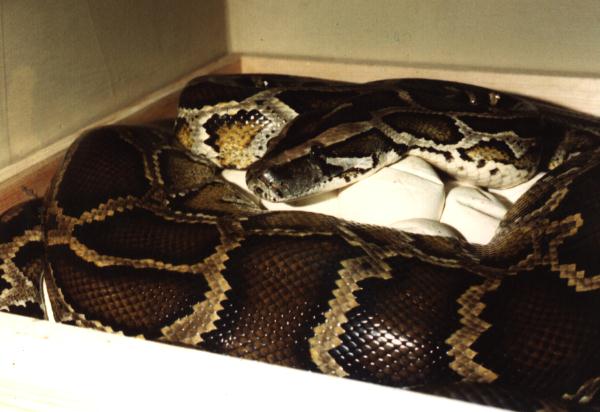
Burmese Pythons can be kept in a wide range of different cages. Most owners choose a glass aquarium for young pythons that are smaller than 4 feet in length. A tank that is 36 in x 18 in x 18 in is large enough to hold a pair of Burmese pythons that are smaller than 4 feet in length. Once your Burmese Python has outgrown these living arrangements you may want to upgrade your cage to a wooden terrarium. This can be made out of practically anything. Just as long as it is waterproof and well ventilated. Many enthusiasts use this oppurtunity to become inventive. They may use anything from old closets to tv cabinets.
No matter what kind of cage you use, there are a few important rules that must be followed. Your terrarium must have a secured lid. Burmese Pythons are very strong and will be able to push off a loose lid. They are also very difficult to find once they have escaped (take my word for it).
It is very important to maintain a correct temperature for your Burmese python. Pythons are cold blooded, meaning that they get their body temperature from their surroundings. It is recommended that the temperature be between 80 and 90 degrees during the daytime, and anywhere down to 70 degrees at night.
Most pet stores sell heat rocks and heating pads that work quite nicely. You will also want to buy heat lamps for your tank. That will be discussed more under the lighting section. You will want to purchase a heat source that is easily turned on and off to better be able to regulate the temperature of your cage.
Even though pythons are nocturnal animals, they are still affected by the night and day cycles. You will want to purchase lamps and bulbs to accomodate them in this manner. It is more beneficial to purchase heat lamps to add extra warmth to your Burmese's cage. Both of these types of light and bulbs are available at your local pet store. No matter which one you decide to purchase, make sure that your Burmese can not come into physical contact with the lamp. This will prevent them from getting some bad burns. As mentioned, Burmese are affected by the night and day cycles so it is important to turn the light off during the night, and on again in the morning to give the illusion of night and day. If you need to keep extra warmth in the cage during the night, then you may want to consider purchasing low-wattage blue or red lamps to have on during the night. These work nicely to keep your cage from getting too cold at night.
There are many other furnishings for your Burmese that you may want to consider. One furnishing that is absolutely necessary is a water bowl. Pythons do drink and like to submerge themselves in water if their environment is too warm. The water bowl must be large enough for your Burmese to totally submerge his entire body in, and must be cleaned regularly to prevent infections and transfer of diseases. When cleaning the water bowl, do not just pour out the old water and add new water. You must scrub the bowl out with soap and water to remove all bacteria.
Another furnishing that is necessary is some kind of substrate. Many different items can be used such as: paper towels, newspaper, wood chips, pieces of carpet, or even old bath towels. If you choose to use wood chips, make sure that they are not cedar chips. The oils in the cedar chips irritate the snakes skin. No matter what you choose to use, make sure that you keep it clean and change it at regular intervals.
You may also want to add a tree branch or two to your cage for your Burmese. Burmese pythons are naturally climbers and will appreciate a good branch to climb on. They also need a place to hide every once and a while, so you may want to add a hollow log for them to hide under. Make sure that there is enough room for you to be able to see the snake and to easily gain access to them if necessary. These are added extras for your pet Burmese, so feel free to get creative. The more crooked and curvy the branch the better. Be original and have fun.
At some point or another you will be faced with the task of transportin your python without harming them. This is a fairly simple task if you follow a few rules.
One of the main things you need to do is to find a sack to carry your python in. This sack should be large enough for your python to fit comfortably inside. Air should also be able to pass easily through the sack so that your python does not suffocate. Pillow cases work well for most pythons. You can also buy special sacks made out of soft cloth that works well also.
Another factor that affects how you transport your python is the distance you are traveling. If you are only traveling short distances then you can safely place your python (in a sack) on the floor of your car. If your are traveling longer distances, then it would be better to place the sack and python in a box. Multiple pythons should be placed in individual boxes. If the weather is cold outside you should insulate each box with towels or something of that sort. Whatever you use, make sure that your python is comfortable.
